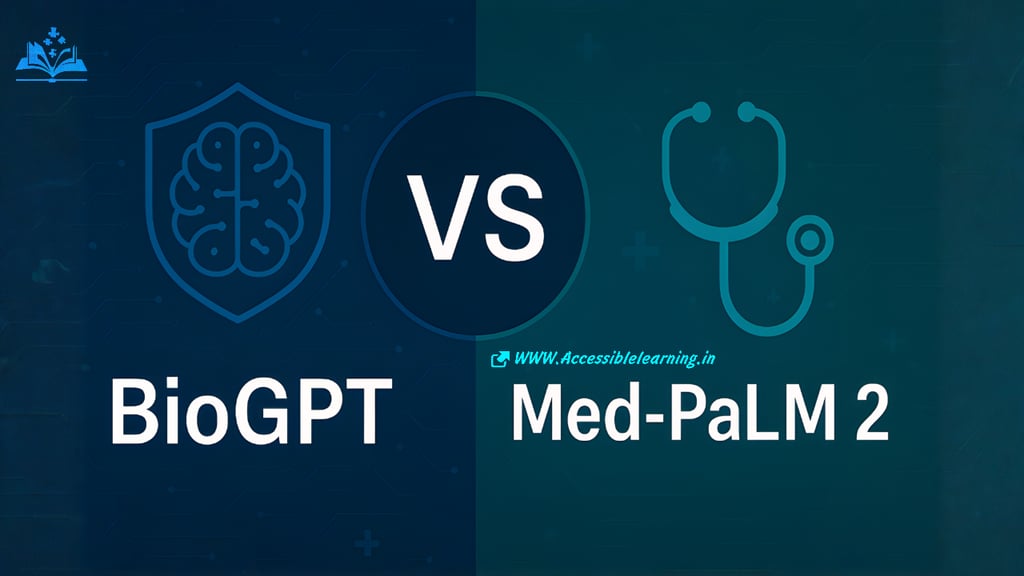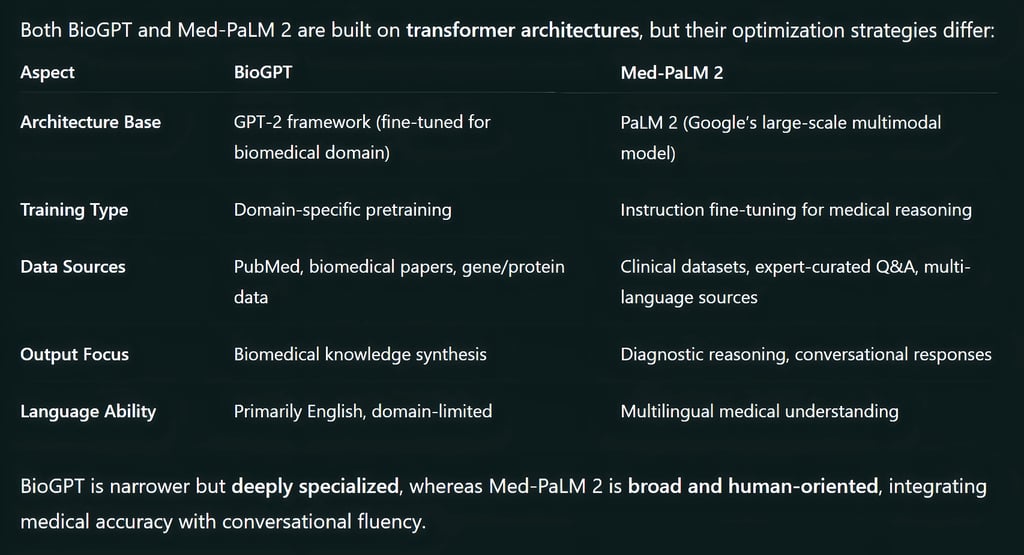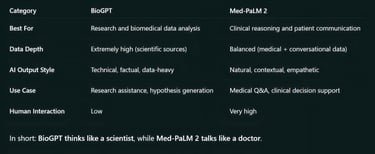
BioGPT vs Med-PaLM 2: How AI Is Transforming Medical Knowledge and Healthcare
This in-depth comparison explores how Microsoft’s BioGPT and Google’s Med-PaLM 2 transform biomedical research, clinical reasoning, and patient communication. Learn their unique strengths, real-world applications, and how both are shaping the future of AI-driven healthcare and medical knowledge systems.
AI ASSISTANTHEALTH/DISEASEAI/FUTURE
Sachin K Chaurasiya
11/21/20257 min read


Artificial intelligence is transforming how medicine is practiced, researched, and delivered. Among the leading advancements are specialized language models like BioGPT and Med-PaLM 2, two powerful systems designed to understand and generate medical knowledge. While both aim to bridge the gap between clinical data and human understanding, their core design philosophies, data sources, and applications differ significantly.
This article explores BioGPT vs Med-PaLM 2 in depth—how they function, where they excel, and what they mean for the future of AI-driven healthcare.
BioGPT: The Biomedical Language Expert
Developed by Microsoft Research, BioGPT is a transformer-based language model trained specifically on biomedical literature such as PubMed abstracts, clinical studies, and research papers. Its primary goal is to assist researchers, clinicians, and biologists in extracting scientific insights, summarizing findings, and generating hypotheses from complex medical data.
Focus: Biomedical text generation and understanding
Training Data: Millions of PubMed abstracts and scientific journals
Main Users: Medical researchers, biotechnologists, pharmacologists
BioGPT specializes in understanding biomedical terminology and scientific nuance, making it incredibly useful for drug discovery, disease modeling, and knowledge mining.
Real-World Applications
Drug Discovery and Pharmacology: BioGPT helps identify relationships between compounds, diseases, and genes—accelerating drug development cycles.
Biomedical Literature Mining: It can read and summarize thousands of scientific abstracts, helping researchers keep pace with rapidly growing knowledge.
Precision Medicine Research: Assists in exploring personalized treatment pathways by mapping genetic and molecular data.
Limitations
Struggles with non-research conversational queries.
Lacks understanding of clinical context or patient safety guidelines.
May reproduce outdated or biased data if source literature is not recent.

Med-PaLM 2: The Conversational Medical AI
Med-PaLM 2, developed by Google DeepMind, is an extension of Google’s PaLM 2 large language model, fine-tuned for medical question answering and clinical reasoning. It’s designed not just to understand medical text but to converse with healthcare professionals and patients in a safe and accurate manner.
Focus: Clinical reasoning and patient-focused medical dialogue
Training Data: Curated medical datasets, clinical reports, and human-reviewed Q&A datasets
Main Users: Physicians, medical educators, healthcare systems
Med-PaLM 2’s unique capability lies in answering U.S. Medical Licensing Exam (USMLE)-style questions with near-expert accuracy—achieving results comparable to trained medical professionals.
Real-World Applications
Clinical Decision Support: Assists doctors with evidence-based recommendations, differential diagnoses, and treatment explanations.
Patient Education: Simplifies complex medical terminology into understandable explanations for patients.
Medical Training and Simulation: Helps medical students practice case-based reasoning and clinical communication.
Telemedicine Integration: Provides real-time medical conversation support for virtual consultations.
Limitations
While conversational, it must be carefully validated before being deployed clinically.
May face challenges with regional medical terminology and ethical compliance in sensitive discussions.
Requires human oversight to ensure no misinformation or bias in patient-facing outputs.




The Future of Medical AI: Collaboration, Not Competition
The future of AI in medicine isn’t about which model “wins,” but how they complement each other.
BioGPT’s strength in biomedical research could power the backend of medical discovery engines.
Med-PaLM 2 could serve as the front-end interface, engaging clinicians and patients directly.
Together, they represent the convergence of data intelligence and human-centered care, marking a new era of AI-driven medical ecosystems.
Evolution of Medical Language Models
The emergence of BioGPT and Med-PaLM 2 marks the second generation of medical AI models, moving beyond basic question answering toward specialized cognitive reasoning.
BioGPT evolved from scientific NLP efforts in genomics and bioinformatics.
Med-PaLM 2 evolved from large-scale language models (LLMs) like PaLM and Gemini, integrating multimodal understanding (text, image, and structured data).
This evolution reflects a growing demand for precision AI in healthcare—one model serving researchers, another serving caregivers and patients.
Integration with Healthcare Infrastructure
Both models are being tested for integration into hospital ecosystems, but in different ways:
BioGPT can be linked to clinical research databases or pharmaceutical R&D systems** to accelerate evidence synthesis.
Med-PaLM 2 is being tested in pilot programs with hospitals and health institutions (like Mayo Clinic) for clinical consultation support, electronic health record (EHR) summarization, and virtual triage.
The long-term vision: seamless AI-augmented healthcare environments where BioGPT powers data discovery and Med-PaLM 2 supports human interaction.
Medical Language Reasoning
BioGPT focuses on terminology precision—it understands relationships between proteins, genes, diseases, and treatments.
Med-PaLM 2 focuses on reasoning and empathy—it interprets symptoms, evaluates possible conditions, and communicates in patient-friendly terms.
This distinction makes BioGPT better at “why things happen,” while Med-PaLM 2 excels at “what should be done.”
Multimodal and Cross-Domain Learning
Unlike BioGPT, which is purely text-based, Med-PaLM 2 has multimodal capabilities—it can analyze medical images, lab results, and textual notes simultaneously.
This enables radiology report generation, pathology slide analysis, and lab test interpretation.
Future versions of BioGPT may integrate molecular and visual data, but for now, it remains text-specialized.

Explainability and Transparency
Explainable AI (XAI) is a critical concern in healthcare.
BioGPT uses attention visualization tools to trace how certain biomedical relationships are inferred.
Med-PaLM 2 is being fine-tuned for “chain-of-thought transparency,” allowing doctors to review the model’s reasoning steps before accepting an answer.
This emphasis on interpretability ensures that AI systems don’t just provide results—they justify them, which is essential in clinical settings.
Data Privacy and Compliance
Medical AI must comply with HIPAA, GDPR, and other health data protection laws.
BioGPT typically works with publicly available research data, making it lower-risk in terms of privacy.
Med-PaLM 2, however, interacts with sensitive patient information, so Google employs encryption, federated learning, and anonymization to meet compliance standards.
Such frameworks are key to maintaining ethical integrity and trust in AI-driven healthcare.
Collaboration with Human Experts
Both models are most effective when paired with human oversight:
Researchers use BioGPT to analyze complex patterns, then validate findings experimentally.
Doctors use Med-PaLM 2 as a second opinion tool, ensuring clinical safety before acting on suggestions.
Rather than replacing professionals, these systems extend human intelligence in research and practice.
Training Efficiency and Resource Consumption
BioGPT’s focused domain allows for lighter computational training, making it faster and more efficient for research environments.
Med-PaLM 2, built on Google’s PaLM infrastructure, is vast and resource-heavy, leveraging massive TPU clusters for large-scale pretraining and fine-tuning.
The difference reflects their respective goals: precision versus generalization.
Industry Adoption and Partnerships
BioGPT is being explored by biotech startups and pharmaceutical companies for AI-assisted drug repurposing and genomic studies.
Med-PaLM 2 is being integrated into Google Health’s pilot programs and used for AI-driven diagnostics and medical education platforms.
Their ecosystem adoption suggests that AI in healthcare is shifting from “research-only tools” to enterprise-level medical collaborators.
The Path Ahead
BioGPT may evolve into a BioGPT-2, expanding into protein structures, molecular simulations, and bioinformatics visualization.
Med-PaLM 2 could merge with Google’s Gemini architecture, adding real-time visual diagnostics and multilingual telemedicine support.
These trajectories indicate a future where both AI systems interconnect—BioGPT generating deep scientific knowledge, and Med-PaLM 2 delivering that knowledge in an accessible, actionable form.
Global Impact on Medical Equity
Med-PaLM 2’s multilingual capabilities open pathways for medical democratization, offering healthcare knowledge to regions with limited medical infrastructure.
BioGPT contributes by accelerating vaccine research, epidemic prediction, and biomedical innovation that benefits global health resilience.
Together, they represent how AI can close both the knowledge gap and the access gap in global healthcare.
The Human-Centered AI Perspective
Both models underscore a key paradigm shift:
Medical AI is not about replacing doctors or scientists, but about enhancing human understanding.
The real success lies in how these systems empower people—whether it’s a researcher discovering a cure faster or a patient understanding their diagnosis clearly.

Key Takeaways
BioGPT is ideal for biomedical research, drug discovery, and data mining.
Med-PaLM 2 is built for clinical reasoning, education, and patient communication.
Both models enhance different layers of healthcare: knowledge creation and knowledge delivery.
Ethical deployment and human oversight remain essential.
The collaboration of such AIs will define the next-generation digital healthcare landscape.
The comparison between BioGPT vs Med-PaLM 2 highlights two vital branches of medical AI evolution—scientific depth and clinical empathy. BioGPT empowers research innovation, while Med-PaLM 2 supports real-world medical communication. Both are not replacements for healthcare professionals but powerful tools to augment human expertise, speed up discoveries, and make healthcare more intelligent and inclusive.
The medical field is stepping into a future where AI doesn’t just analyze data—it understands the humanity behind it.
FAQs
Q: What is BioGPT used for in healthcare?
BioGPT is primarily used for biomedical research, literature mining, and drug discovery. It helps scientists extract insights from massive medical databases like PubMed, identify connections between diseases and genes, and assist in developing new treatment hypotheses.
Q: How does Med-PaLM 2 differ from BioGPT?
Med-PaLM 2 is designed for clinical reasoning and medical communication, whereas BioGPT focuses on scientific and research data analysis. Med-PaLM 2 can converse with doctors and patients in natural language, while BioGPT operates best within structured scientific contexts.
Q: Is Med-PaLM 2 capable of diagnosing patients?
Not independently. Med-PaLM 2 can suggest possible conditions or treatments based on medical input, but it is not a substitute for professional medical diagnosis. It assists healthcare providers by summarizing evidence and improving decision-making, always under human supervision.
Q: Can BioGPT be integrated into existing medical research systems?
Yes. BioGPT can be integrated with biomedical databases, R&D platforms, and AI-assisted research tools to enhance drug discovery and genomic exploration. It’s especially useful for data correlation and hypothesis generation in biotechnology and pharmaceutical environments.
Q: How accurate is Med-PaLM 2 in medical question answering?
In evaluations like the USMLE benchmark tests, Med-PaLM 2 achieved expert-level accuracy (above 85%), often providing reasoning aligned with real-world medical standards. However, it still requires validation from qualified healthcare professionals before use in clinical practice.
Q: Does BioGPT understand clinical conversations or patient notes?
Not effectively. BioGPT is trained mainly on academic biomedical text, not conversational or patient-centered data. It struggles with subjective information or contextual nuances present in clinical notes, which is where Med-PaLM 2 performs better.
Q: How do these models handle medical data privacy?
Both models operate under strict data handling frameworks.
BioGPT typically processes publicly available research data, reducing privacy concerns.
Med-PaLM 2, being used in clinical contexts, follows HIPAA and GDPR compliance, employing secure data encryption and anonymization protocols to protect patient data.
Q: Which AI model is better for hospitals and clinical use?
Med-PaLM 2 is better suited for clinical and patient-facing environments due to its conversational design and reasoning ability. BioGPT, however, is ideal for research institutions, pharmaceutical companies, and bioinformatics projects. Both serve complementary roles in the healthcare ecosystem.
Q: Can these AI models replace doctors or medical researchers?
No. Neither BioGPT nor Med-PaLM 2 is meant to replace medical professionals. They are assistive tools designed to enhance human expertise, improve research efficiency, and reduce cognitive load for healthcare workers. Human judgment remains essential.
Q: What is the future of AI in medical knowledge systems?
The next generation of medical AI will likely merge the strengths of both BioGPT and Med-PaLM 2—combining deep scientific insight with clinical empathy. Future systems may offer real-time medical reasoning, multilingual patient support, and collaborative research intelligence, leading to a more connected and data-driven healthcare world.
Subscribe to our newsletter
All © Copyright reserved by Accessible-Learning
| Terms & Conditions
Knowledge is power. Learn with Us. 📚


